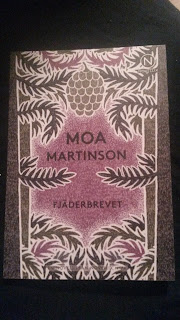I have been sick with a cold these past few days, so it was nice to relax with a short story in the meantime. I chose Moa Martinson's Fjäderbrevet (The feather letter)* mostly because I liked the cover, but it turned out to be a quite interesting read.
My past experiences with Martinson's authorship has actually been quite mixed. When I was 15 and was "forced" to read her book Mor gifter sig (1936) in school I found it quite boring which might be because I was so young and I read it as a school assignment. Therefore I will not talk much about it. The second book I read by Martinson was a much more pleasant read: Kvinnor och äppelträd (1933). It is definitely up there among my favourite books of all time and I will give it its own entry in the future.
 |
| Moa Martinson |
När mor berättade om knekttorpet, där både hon och jag var födda, och då hon drog sig till minnes historier hennes mormor som var född på sjuttonhundratalet hade berättat, så fick jag det intrycket att det var knekthustrurna, knetsystrarna och knektmödrarna som var armén (When mother told about the soldier's croft, where both she and I were born, and when she remembered stories her grandmother who was born during the 18th century hade told, I got the feeling that it was the soldiers's wives, sisters and mothers who were the army.)
I really enjoy Moa Martinson's language. Her portrayal of her contemporary society and the people at its bottom (especially the women) is so raw and straight forward. It really gets you into the hardship of the society of that time (late 19th-early 20th century Sweden). Martinson belongs to the Swedish working class authors of the first half of the 20th century and I think it is very important for people today to read that type of literature in a way. It is raw and humanistic and paints a picture of a society that people today are rather unaware of existed only about a 100 years ago. Yes, Martinson's main focus is the poor, but that does not mean that she does not have feelings for the rich. Quite the contrary actually:
Man står inte ut med ens i fantasin att en människa, okunnig om sin ondska, sin girighet och hårdhet, inte ska få tillfälle till bättring. Livets egen happy end är ju döden för varenda varelse som föds. (You cannot stand even in your imagination that a human being without knowledge of his/her malignity, his/her greed and hardness will never have the opportunity to do right. The life's own happy end is death for every living being that is born.)
*Urgent post delivery was up until the 1870's in Finland and Sweden marked by feathers and therefore called Fjäderbrev

Inga kommentarer:
Skicka en kommentar